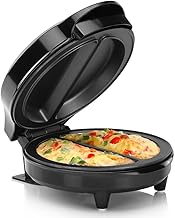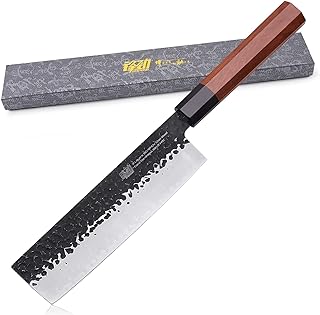5 important factors worth considering when looking for the best nakiri
When choosing a Nakiri knife, it’s important to be careful and precise because it can make a big difference in how you cook. Paying attention to details is crucial, as each feature works together to create a top-notch kitchen tool. To understand what makes a Nakiri knife special, you need to consider its craftsmanship, blade, handle, and performance. By exploring these aspects, you can improve your cooking skills and create delicious meals.
See our guide to the best nakiri.
Blade material
When choosing the perfect nakiri knife, it’s important to consider the type of steel used for the blade. The steel not only affects how sharp the knife is, but also how long it will last and how well it performs. I believe that high-carbon stainless steel blades are the best choice. These blades are very sharp and stay sharp for a long time. They are also resistant to rust, so they will last a long time and keep cutting well. High-carbon stainless steel is also a good balance of hard and flexible, so it makes chopping and slicing vegetables easy and precise.
High-carbon stainless steel blades are a good investment for anyone who loves to cook. With the right care, these blades can handle tough cooking tasks without getting damaged. The great performance and long life of high-carbon stainless steel blades in nakiri knives make them a top choice for people who want efficient and high-quality kitchen tools. Choosing high-carbon stainless steel for a nakiri knife ensures that you have a sharp, strong, and dependable tool that will enhance your cooking experience.
Blade shape and edge angle
When you look at the shape and angle of the blade on a nakiri knife, it’s important to understand what makes this Japanese cooking tool special. The rectangle-shaped blade of a nakiri allows for quick and accurate cuts, perfect for slicing and dicing vegetables smoothly. The straight edge makes it easy to rock the knife back and forth, giving you even cuts every time. When you combine this design with a super-sharp edge, you get a knife that can slice veggies cleanly and precisely, taking your cooking to the next level. The way the blade shape and edge angle work together in a nakiri knife shows how well form and function can come together in one essential kitchen tool.
Additionally, the way the blade shape and edge angle of the nakiri knife work together reflects Japan’s dedication to making knives with care and innovation. The flat blade lets you chop veggies with stability and control by keeping the knife in full contact with the cutting board. With a sharp edge that can effortlessly slice through tough veggies, the nakiri strikes a great balance between sharpness and durability. This carefully crafted knife demonstrates a commitment to making cooking easier and more enjoyable, going beyond just being functional. Choosing to use a nakiri knife not only improves your cooking precision, but it also honors a long culinary tradition that inspires chefs all over the world.
Handle material and design
When choosing a nakiri knife, the handle material and design are important for more than just looks. The handle affects how well the knife performs and how comfortable it is to use. Wooden handles look traditional and feel warm, but they need more care and can wear out over time. Synthetic handles like G-10 or Micarta are durable, resistant to moisture, and provide a better grip, especially in wet conditions. It’s important to consider how the handle feels and how well it works with your cutting style for precise and efficient kitchen tasks.
The handle design can also make a big difference in your cooking experience. A balanced handle that fits well in your hand can reduce fatigue and improve control, making it easier to cut ingredients precisely. Whether you like a classic D-shape handle, a Western-style full-tang handle, or a Japanese octagonal handle, choose one that feels comfortable and works with your cutting style. The handle material and design should work well with the blade to create an efficient tool that enhances your culinary skills.
Balance and weight
When choosing a nakiri knife, it’s important to consider the balance and weight of the blade. Finding the right balance between the handle and blade weight is key for easy and precise vegetable cutting. A well-balanced knife not only improves the cutting experience but also reduces fatigue during long periods of use. The weight distribution should make the knife feel like a natural extension of your hand, allowing for smooth movements with minimal strain on your wrist and arm muscles.
The weight of the knife can affect your control and precision when cutting vegetables. A light knife gives you more agility for intricate cuts, while a heavier blade offers stability and power for tougher fruits and vegetables. The perfect balance and weight of the knife depend on personal preference and the types of cooking tasks you do most often. It’s important to try out different options to find a knife that feels comfortable and easy to use, making kitchen prep enjoyable rather than a chore.
Price and budget
When you’re choosing a nakiri knife, it’s important to find the right balance between price and quality. While a more expensive knife can improve your cooking experience, you should consider if it’s worth the cost based on your needs and skill level. A high-end nakiri made with top-notch materials and craftsmanship may be great for experienced chefs or enthusiasts who value precision and durability. But if you’re new to Japanese knives or just cooking at home, starting with a more affordable option might be a better idea. A mid-range nakiri that combines quality with affordability can help you improve your skills without spending too much money, making it easier to adapt to using Japanese knives.
Keep in mind that the price of a nakiri reflects not just how it’s made, but also the brand, history, and exclusivity it offers. Some people see an expensive nakiri as a status symbol and a sign of quality, while others prefer a reasonably priced knife that simply does the job well. Ultimately, how much you should spend on a nakiri depends on your own needs, preferences, and culinary goals. By thinking carefully about your budget and what features are important to you, you can find a nakiri that fits your needs and becomes an essential tool in your kitchen for years to come.
Conclusion
Overall, the Nakiri knife is a must-have tool for anyone who loves cooking. It combines timeless elegance with practical versatility. The knife’s precise, efficient, and ergonomic design blends tradition with innovation, making it perfect for slicing with accuracy. Whether you’re a seasoned chef or a beginner at home, the Nakiri knife showcases the artistry and craftsmanship of high-quality culinary tools. Want more info on cutest hair clips, check the best cutest hair clips.

